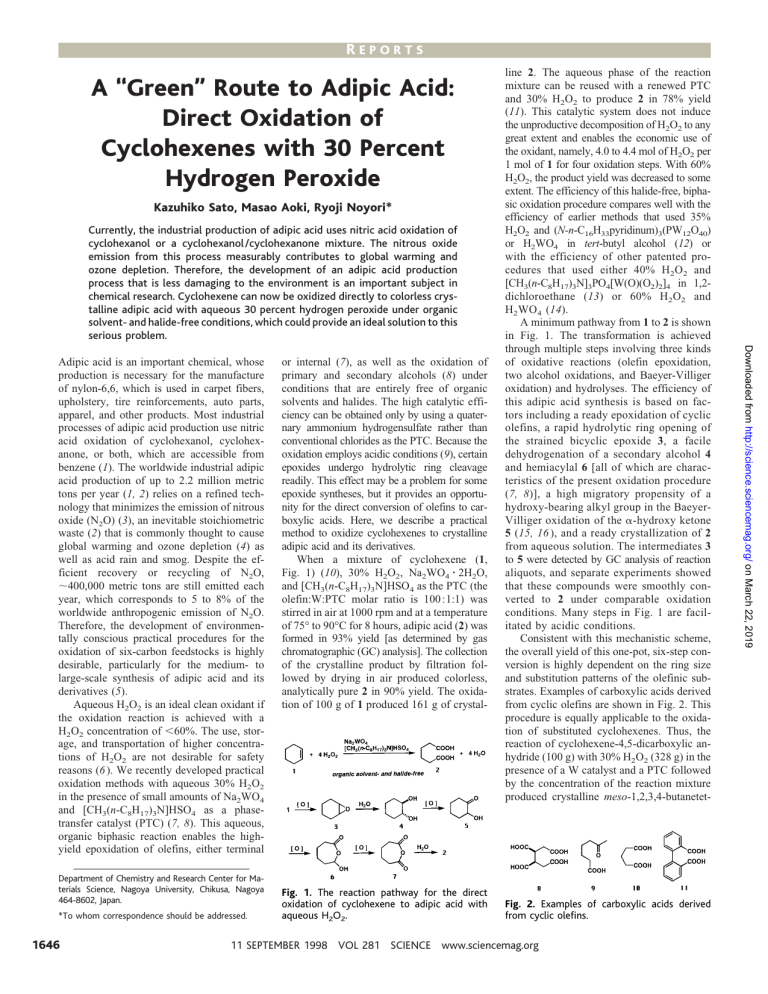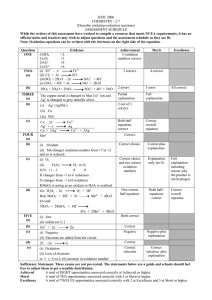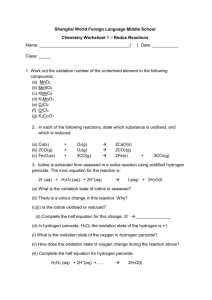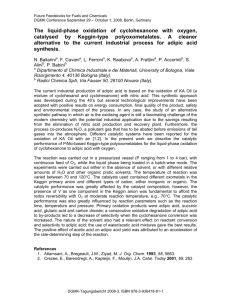
REPORTS
A “Green” Route to Adipic Acid:
Direct Oxidation of
Cyclohexenes with 30 Percent
Hydrogen Peroxide
Kazuhiko Sato, Masao Aoki, Ryoji Noyori*
Currently, the industrial production of adipic acid uses nitric acid oxidation of
cyclohexanol or a cyclohexanol /cyclohexanone mixture. The nitrous oxide
emission from this process measurably contributes to global warming and
ozone depletion. Therefore, the development of an adipic acid production
process that is less damaging to the environment is an important subject in
chemical research. Cyclohexene can now be oxidized directly to colorless crystalline adipic acid with aqueous 30 percent hydrogen peroxide under organic
solvent- and halide-free conditions, which could provide an ideal solution to this
serious problem.
Department of Chemistry and Research Center for Materials Science, Nagoya University, Chikusa, Nagoya
464-8602, Japan.
*To whom correspondence should be addressed.
1646
or internal (7), as well as the oxidation of
primary and secondary alcohols (8) under
conditions that are entirely free of organic
solvents and halides. The high catalytic efficiency can be obtained only by using a quaternary ammonium hydrogensulfate rather than
conventional chlorides as the PTC. Because the
oxidation employs acidic conditions (9), certain
epoxides undergo hydrolytic ring cleavage
readily. This effect may be a problem for some
epoxide syntheses, but it provides an opportunity for the direct conversion of olefins to carboxylic acids. Here, we describe a practical
method to oxidize cyclohexenes to crystalline
adipic acid and its derivatives.
When a mixture of cyclohexene (1,
Fig. 1) (10), 30% H2O2, Na2WO4 z 2H2O,
and [CH3(n-C8H17)3N]HSO4 as the PTC (the
olefin:W:PTC molar ratio is 100 :1:1) was
stirred in air at 1000 rpm and at a temperature
of 75° to 90°C for 8 hours, adipic acid (2) was
formed in 93% yield [as determined by gas
chromatographic (GC) analysis]. The collection
of the crystalline product by filtration followed by drying in air produced colorless,
analytically pure 2 in 90% yield. The oxidation of 100 g of 1 produced 161 g of crystal-
Fig. 1. The reaction pathway for the direct
oxidation of cyclohexene to adipic acid with
aqueous H2O2.
Fig. 2. Examples of carboxylic acids derived
from cyclic olefins.
11 SEPTEMBER 1998 VOL 281 SCIENCE www.sciencemag.org
Downloaded from http://science.sciencemag.org/ on March 22, 2019
Adipic acid is an important chemical, whose
production is necessary for the manufacture
of nylon-6,6, which is used in carpet fibers,
upholstery, tire reinforcements, auto parts,
apparel, and other products. Most industrial
processes of adipic acid production use nitric
acid oxidation of cyclohexanol, cyclohexanone, or both, which are accessible from
benzene (1). The worldwide industrial adipic
acid production of up to 2.2 million metric
tons per year (1, 2) relies on a refined technology that minimizes the emission of nitrous
oxide (N2O) (3), an inevitable stoichiometric
waste (2) that is commonly thought to cause
global warming and ozone depletion (4) as
well as acid rain and smog. Despite the efficient recovery or recycling of N2O,
;400,000 metric tons are still emitted each
year, which corresponds to 5 to 8% of the
worldwide anthropogenic emission of N2O.
Therefore, the development of environmentally conscious practical procedures for the
oxidation of six-carbon feedstocks is highly
desirable, particularly for the medium- to
large-scale synthesis of adipic acid and its
derivatives (5).
Aqueous H2O2 is an ideal clean oxidant if
the oxidation reaction is achieved with a
H2O2 concentration of ,60%. The use, storage, and transportation of higher concentrations of H2O2 are not desirable for safety
reasons (6 ). We recently developed practical
oxidation methods with aqueous 30% H2O2
in the presence of small amounts of Na2WO4
and [CH3(n-C8H17)3N]HSO4 as a phasetransfer catalyst (PTC) (7, 8). This aqueous,
organic biphasic reaction enables the highyield epoxidation of olefins, either terminal
line 2. The aqueous phase of the reaction
mixture can be reused with a renewed PTC
and 30% H2O2 to produce 2 in 78% yield
(11). This catalytic system does not induce
the unproductive decomposition of H2O2 to any
great extent and enables the economic use of
the oxidant, namely, 4.0 to 4.4 mol of H2O2 per
1 mol of 1 for four oxidation steps. With 60%
H2O2, the product yield was decreased to some
extent. The efficiency of this halide-free, biphasic oxidation procedure compares well with the
efficiency of earlier methods that used 35%
H2O2 and (N-n-C16H33pyridinum)3(PW12O40)
or H2WO4 in tert-butyl alcohol (12) or
with the efficiency of other patented procedures that used either 40% H2O2 and
[CH3(n-C8H17)3N]3PO4[W(O)(O2)2]4 in 1,2dichloroethane (13) or 60% H2O2 and
H2WO4 (14).
A minimum pathway from 1 to 2 is shown
in Fig. 1. The transformation is achieved
through multiple steps involving three kinds
of oxidative reactions (olefin epoxidation,
two alcohol oxidations, and Baeyer-Villiger
oxidation) and hydrolyses. The efficiency of
this adipic acid synthesis is based on factors including a ready epoxidation of cyclic
olefins, a rapid hydrolytic ring opening of
the strained bicyclic epoxide 3, a facile
dehydrogenation of a secondary alcohol 4
and hemiacylal 6 [all of which are characteristics of the present oxidation procedure
(7, 8)], a high migratory propensity of a
hydroxy-bearing alkyl group in the BaeyerVilliger oxidation of the a-hydroxy ketone
5 (15, 16 ), and a ready crystallization of 2
from aqueous solution. The intermediates 3
to 5 were detected by GC analysis of reaction
aliquots, and separate experiments showed
that these compounds were smoothly converted to 2 under comparable oxidation
conditions. Many steps in Fig. 1 are facilitated by acidic conditions.
Consistent with this mechanistic scheme,
the overall yield of this one-pot, six-step conversion is highly dependent on the ring size
and substitution patterns of the olefinic substrates. Examples of carboxylic acids derived
from cyclic olefins are shown in Fig. 2. This
procedure is equally applicable to the oxidation of substituted cyclohexenes. Thus, the
reaction of cyclohexene-4,5-dicarboxylic anhydride (100 g) with 30% H2O2 (328 g) in the
presence of a W catalyst and a PTC followed
by the concentration of the reaction mixture
produced crystalline meso-1,2,3,4-butanetet-
REPORTS
References and Notes
1. D. D. Davis and D. R. Kemp, in Kirk-Othmer Encyclopedia of Chemical Technology, J. I. Kroschwitz and M.
Howe-Grant, Eds. (Wiley, New York, 1991), vol. 1, pp.
466 – 493.
2. M. H. Thiemens and W. C. Trogler, Science 251, 932
(1991).
3. A. Scott, Chem. Week 160 (no. 6) 37 (1998); R. A.
Reimer, C. S. Slaten, M. Seapan, M. W. Lower, P. E.
Tomlinson, Environ. Prog. 13, 134 (1994).
4. R. E. Dickinson and R. J. Cicerone, Nature 319, 109
(1986).
5. For synthesis from D-glucose, see K. M. Draths and
J. W. Frost, J. Am. Chem. Soc. 116, 399 (1994).
6. For international regulations, see Regulations Concerning the International Carriage of Dangerous
Goods by Rail (RID), European Agreement Concerning
the International Carriage of Dangerous Goods by
Road (ADR), International Maritime Dangerous Goods
Code (IMDG Code), International Civil Aviation Organization Technical Instructions for the Safe Transport of Dangerous Goods by Air (ICAO TI), and International Air Transport Association Dangerous Goods
Regulation (IATA DGR).
7. K. Sato, M. Aoki, M. Ogawa, T. Hashimoto, R. Noyori,
J. Org. Chem. 61, 8310 (1996); K. Sato et al., Bull.
Chem. Soc. Jpn. 70, 905 (1997).
8. K. Sato, M. Aoki, J. Takagi, R. Noyori, J. Am. Chem.
Soc. 119, 12386 (1997).
9. For nonacidic epoxidation with aqueous H2O2, see J.
Rudolph, K. L. Reddy, J. P. Chiang, K. B. Sharpless, ibid.,
p. 6189; C. Copéret, H. Adolfsson, K. B. Sharpless,
Chem. Commun. 1997, 1565 (1997).
10. Cyclohexene is produced by the hydrogenation of
benzene for the industrial preparation of 1; see O.
Mitsui and Y. Fukuoka, Japanese Patents 59-184138
and 59-186929 (1984); H. Nagahara and Y. Fukuoka,
ibid. 61-50930 (1986); H. Nagahara and M. Konishi,
ibid. 62-45541 (1987).
11. The typical procedure of oxidation and reuse of the
water phase are given as follows. In the first run, a
1-liter round-bottomed flask equipped with a magnetic stirring bar and a reflux condenser was charged
with 4.01 g (12.2 mmol) of Na2WO4 z 2H2O, 5.67 g
(12.2 mmol) of [CH3(n-C8H17)3N]HSO4, and 607 g
(5.355 mol) of aqueous 30% H2O2. The mixture was
vigorously stirred at room temperature for 10 min
and then 100 g (1.217 mol) of 1 was added. The
biphasic mixture was heated successively at 75°C for
30 min, at 80°C for 30 min, at 85°C for 30 min, and
at 90°C for 6.5 hours, with stirring at 1000 rpm. The
homogeneous solution was allowed to stand at 0°C
for 12 hours, and the resulting white precipitate was
separated by filtration and washed with 20 ml of cold
water. The product was dried in a vacuum to produce
138 g (78% yield) of 2 as a white solid (with a
melting point of 151.0° to 152.0°C). A satisfactory
elemental analysis was obtained without further purification. Concentration of the mother liquor produced 23 g of pure 2; the yield determined by GC
(OV-1 column, 0.25 mm by 50 m, GL Sciences,
Tokyo) was 93%. The identified byproducts were
1,2-cyclohexanediol (2% yield) and glutaric acid (4%
yield). In the second run, a 2-liter round-bottomed
flask was charged with the water phase of the first
run, which contained the W catalyst, 5.67 g (12.2
mmol) of [CH3(n-C8H17)3N]HSO4, and 552 g (4.868
mol) of aqueous 30% H2O2. After the mixture was
vigorously stirred at room temperature for 10 min,
100 g (1.217 mol) of 1 was added. This mixture was
heated successively at 75°C for 30 min, at 80°C for
30 min, at 85°C for 30 min, and at 90°C for 46.5
hours, with stirring at 1000 rpm; the homogeneous
solution was allowed to stand at 0°C for 12 hours.
The resulting white precipitate was separated,
12.
13.
14.
15.
16.
17.
18.
19.
washed, and dried in a vacuum to produce 138 g
(78% yield) of analytically pure 2 as a white solid.
Y. Ishii et al., J. Org. Chem. 53, 3587 (1988); T.
Oguchi, T. Ura, Y. Ishii, M. Ogawa, Chem. Lett. 1989,
857 (1989).
C. Venturello and M. Ricci, European Patent 0 122
804 (1984).
T. Fujitani and M. Nakazawa, Japanese Patent 6393746 (1988). An experiment that we conducted
under the reported conditions produced a 61% yield
of 2 that was contaminated with glutaric acid (5%
yield), peroxy acids (5% yield), and 1,2-cyclohexanediol (3% yield). With 35% H2O2 and a H2WO4
catalyst, only a trace amount of 2 was obtained (12).
L. Knof, Liebigs Ann. Chem. 656, 183 (1962); G. M.
Rubottom, J. M. Gruber, R. K. Boeckman Jr., M. Ramaiah, J. B. Medwid, Tetrahedron Lett. 1978, 4603
(1978).
Under the standard conditions of alcohol oxidation,
Baeyer-Villiger ring enlargement of simple cyclohexanones is negligible (8). A separate experiment
showed that 1,2-cyclohexanedione is not a reaction
intermediate.
For nitric acid oxidation, see J. E. Franz, J. F. Herber,
W. S. Knowles, J. Org. Chem. 30, 1488 (1965).
Eur. Chem. News 66, 41 (1996); L. W. Gosser, U.S.
Patent 4,681,751 (1987).
We are grateful to N. Imaki and T. Setoyama (Mitsubishi Chemical Company, Tokyo), M. Kagotani (Daicel Chemical Industries, Osaka), T. Kurai (Mitsubishi
Gas Chemical Company, Tokyo), M. Minai (Sumitomo
Chemical Industry, Tokyo), and K. Nakagawa (Asahi
Chemical Industry Company, Tokyo) for their valuable comments from industrial points of view. This
work was supported by the Ministry of Education,
Science, Sports, and Culture, Japan (grant 07CE2004).
2 June 1998; accepted 23 July 1998
Onset of Catalytic Activity of
Gold Clusters on Titania with
the Appearance of Nonmetallic
Properties
M. Valden,* X. Lai, D. W. Goodman†
Gold clusters ranging in diameter from 1 to 6 nanometers have been prepared
on single crystalline surfaces of titania in ultrahigh vacuum to investigate the
unusual size dependence of the low-temperature catalytic oxidation of carbon
monoxide. Scanning tunneling microscopy/spectroscopy (STM/STS) and elevated pressure reaction kinetics measurements show that the structure sensitivity of this reaction on gold clusters supported on titania is related to a
quantum size effect with respect to the thickness of the gold islands; islands
with two layers of gold are most effective for catalyzing the oxidation of carbon
monoxide. These results suggest that supported clusters, in general, may have
unusual catalytic properties as one dimension of the cluster becomes smaller
than three atomic spacings.
An atomic-level understanding of structureactivity relations in surface-catalyzed reactions is one of the most important goals of
Department of Chemistry, Texas A&M University,
College Station, TX 77842–3012, USA.
*Visiting Scientist, Department of Physics, Tampere University of Technology, Tampere, FIN 33101, Finland.
†To whom correspondence should be addressed: Email: goodman@chemvx.tamu.edu
surface science studies related to heterogeneous catalysis. Planar model catalysts (1–3)
consisting of metal clusters supported on thin
(2.0 to 10 nm) oxide films simulate the critical features of most practical high surface
area metal catalysts, yet are tractable for a
wide range of surface analytical probes. The
oxide films (SiO2, Al2O3, TiO2, MgO) used
are thin enough to be suitably conductive for
use with various electron spectroscopies in-
www.sciencemag.org SCIENCE VOL 281 11 SEPTEMBER 1998
1647
Downloaded from http://science.sciencemag.org/ on March 22, 2019
racarboxylic acid (8) (141 g) directly in 91%
yield, which is an important intermediate for
synthetic resins and flexibilizers. Cyclohexene-cis-4,5-dicarboxylic acid was also convertible to 8 in 96% yield (17). Under standard conditions, 1-methylcyclohexene was
converted to 6-oxoheptanoic acid (9) in 59%
yield. Oxidation of cyclopentene (100 g) with
30% H2O2 (736 g), Na2WO4 z 2H2O (4.84 g),
and [CH3(n-C8H17)3N]HSO4 (6.84 g) at 70°
to 90°C for 13 hours produced crystalline
glutaric acid (10) (175 g) in 90% yield. Oxidative cleavage of the C(9)–C(10) bond of
phenanthrene with the aid of (aminomethyl)phosphonic acid (7) produced 2,29-biphenyldicarboxylic acid (11) in 41% yield. Cyclooctene and 1-octene produced suberic acid
and heptanoic acid in only 9 and 36% yield,
respectively, because the initially formed epoxides are resistant to hydrolytic cleavage.
This solvent- and halide-free oxidation of
cyclohexene and cyclopentene is clean, safe,
and reproducible, with conditions that are
less corrosive than those of the nitric acid
oxidation. No operational problems are foreseen for a large-scale version of this “green”
process, and technical refinement should further increase the synthetic efficiency. The
worldwide chemical industry is directing extensive efforts toward the efficient production
of H2O2 as a clean, selective oxidant (18).
Thus, this environmentally conscious, non–
nitric acid route to adipic acids will be attractive only if the cost of H2O2 is considerably
reduced or if the regulations regarding N2O
emission become more stringent.
A "Green" Route to Adipic Acid: Direct Oxidation of Cyclohexenes with 30 Percent Hydrogen
Peroxide
Kazuhiko Sato, Masao Aoki and Ryoji Noyori
Science 281 (5383), 1646-1647.
DOI: 10.1126/science.281.5383.1646
http://science.sciencemag.org/content/281/5383/1646
REFERENCES
This article cites 13 articles, 1 of which you can access for free
http://science.sciencemag.org/content/281/5383/1646#BIBL
PERMISSIONS
http://www.sciencemag.org/help/reprints-and-permissions
Use of this article is subject to the Terms of Service
Science (print ISSN 0036-8075; online ISSN 1095-9203) is published by the American Association for the Advancement of
Science, 1200 New York Avenue NW, Washington, DC 20005. 2017 © The Authors, some rights reserved; exclusive licensee
American Association for the Advancement of Science. No claim to original U.S. Government Works. The title Science is a
registered trademark of AAAS.
Downloaded from http://science.sciencemag.org/ on March 22, 2019
ARTICLE TOOLS




